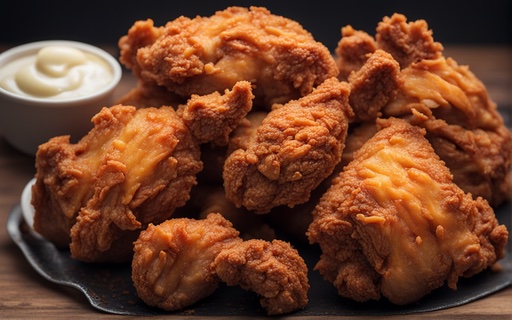Internet Asks: "Can You Fry Chicken in Olive Oil?"
Frying chicken is a universally loved cooking method, known for its crispy texture and rich flavor. However, health-conscious cooks often wonder about the best oil for frying. Olive oil, with its reputation for health benefits, comes up frequently in this discussion. This article explores the feasibility and implications of frying chicken in olive oil.
sponsored links

Can You Fry Chicken in Olive Oil?
The short answer is yes, you can fry chicken in olive oil. Olive oil, particularly extra-virgin olive oil (EVOO), is famed for its monounsaturated fats and polyphenols, contributing to its health-promoting properties. When considering it for frying chicken, two factors are crucial:
- - Smoke Point Consideration: Extra-virgin olive oil has a smoke point of 375-405°F (190-210°C), suitable for frying chicken at moderate temperatures. Refined olive oils, with higher smoke points, can be used for higher temperature frying.
- - Flavor Profile: Olive oil can impart a subtle, unique flavor to the chicken, enhancing its overall taste.
Benefits of Using Olive Oil
Using olive oil to fry chicken brings several health benefits, making it a healthier choice compared to traditional frying oils:
- - Healthier Fats: Olive oil is rich in heart-healthy monounsaturated fats, unlike the saturated fats found in traditional frying oils.
- - Antioxidant Properties: The polyphenols in olive oil can potentially offer added health benefits, even when used for frying.
- - Reduced Cholesterol: Cooking with olive oil instead of butter or lard can help lower the dish’s cholesterol content.
- - Weight Management: Although olive oil is calorie-dense, its high content of monounsaturated fats can promote satiety, potentially aiding in weight management when consumed in moderation.
- - Flavor Enhancement: Olive oil adds a unique, mildly fruity flavor to fried chicken, enhancing its overall taste.
How to Fry Chicken in Olive Oil
- 1. Choose the Right Oil: Opt for refined olive oil for high-heat frying or extra-virgin olive oil for a lower frying temperature.
- 2. Heat the Oil: Heat the olive oil in a skillet or frying pan to a medium-high temperature, but avoid overheating to prevent smoking.
- 3. Prepare the Chicken: Season and bread the chicken as desired. For a healthier option, consider a light batter or breadcrumbs.
- 4. Frying: Place the chicken pieces in the oil and fry until golden brown, turning occasionally. Ensure the chicken is cooked thoroughly to a safe internal temperature.
- 5. Drain: After frying, place the chicken on a rack or paper towels to drain excess oil.
sponsored links
Considerations and Tips
- - Watch the Temperature: Use a thermometer to monitor the oil temperature and keep it within the safe frying range of olive oil.
- - Batch Frying: Avoid overcrowding the pan to maintain oil temperature and achieve even cooking.
- - Reusing Olive Oil: It's generally not recommended to reuse olive oil for frying multiple times, as it can degrade and produce harmful compounds.
Alternatives to Extra-Virgin Olive Oil
If the smoke point is a concern, consider using refined olive oils like "light" or "pure" olive oil, which have higher smoke points than EVOO and a more neutral flavor.
Conclusion
In summary, frying chicken in olive oil is a viable and health-conscious cooking method. With its beneficial monounsaturated fats and antioxidants, olive oil not only enhances the flavor of fried chicken but also offers a healthier alternative to traditional frying oils. Whether using extra-virgin for its flavor or refined olive oil for higher temperature cooking, it’s a versatile choice that aligns with a health-oriented lifestyle. By managing the temperature and considering the type of olive oil used, cooks can enjoy deliciously fried chicken with the added benefits of olive oil’s nutritious profile.
Disclaimer: This article is for informational purposes only. Consult with a culinary expert or dietitian for personalized cooking advice, particularly if you have specific dietary needs or health concerns.
sponsored links
References
1. Casal S, Malheiro R, Sendas A, Oliveira BP, Pereira JA. Olive oil stability under deep-frying conditions. Food Chem Toxicol. 2010 Oct;48(10):2972-9. doi: 10.1016/j.fct.2010.07.036. Epub 2010 Aug 3. PMID: 20678538.
2. Gorzynik-Debicka M, Przychodzen P, Cappello F, Kuban-Jankowska A, Marino Gammazza A, Knap N, Wozniak M, Gorska-Ponikowska M. Potential Health Benefits of Olive Oil and Plant Polyphenols. Int J Mol Sci. 2018 Feb 28;19(3):686. doi: 10.3390/ijms19030686. PMID: 29495598; PMCID: PMC5877547.
3. University of California, Davis. TEN MYTHS & FACTS ABOUT. https://olivecenter.ucdavis.edu/media/files/myths1933.pdf
4. About Olive Oil. Understanding cooking oil smoke points. https://www.aboutoliveoil.org/understanding-cooking-oil-smoke-points
5. Webstaurant Store. Cooking Oil Smoke Points. https://www.webstaurantstore.com/article/800/cooking-oil-smoke-points.html
People are also reading...
Does Sprite Have Caffeine?
Does Hot Chocolate Have Caffeine?
Does Apple Cider Vinegar Expire?
Apple Cider Vinegar and Cranberry Juice for Weight Loss
See the answer to: "Apple Cider Vinegar and Cranberry Juice for Weight Loss"
️Apple Cider Vinegar and Cranberry Juice Weight Loss
See the answer to: "Apple Cider Vinegar and Cranberry Juice Weight Loss"
Cranberry Juice Apple Cider Vinegar
Does Kahlua Have Caffeine?
Do Cappuccinos Have Caffeine?
caffeine-free-coke-zero?
caffeine-free-dr-pepper?
Calories In a Grilled Cheese?
6 oz Steak Calories?
Ready to level-up?
Create meal plans 10x faster, follow up with your clients through our mobile app, and never struggle with meal planning or recipe management again.